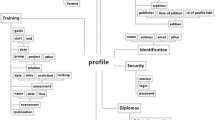Abstract
The paper presents an improved e-learner model that supports monitoring of user behavior related to information security. The model is built upon standardized IMS specification, according to literature research and survey conducted among e-learners. It is positioned as key part of an extended LTSA architecture in which the learner data is used to improve learner security position by continuous delivery of important information and adapting security mechanisms. The implementation is considered in Moodle LMS.








Similar content being viewed by others
References
Mansfield-Devine S 2014 Mobile security: It’s all about behaviour. Netw. Security 2014(11): 16–20. http://doi.org/10.1016/S1353-4858(14)70113-8
Buttler E 2010 Firesheep. Retrieved from http://codebutler.github.io/firesheep/
Chen Y and He W 2013 Security risks and protection in online learning: A survey. The International Review of Research in Open and Distributed Learning. Retrieved from http://www.irrodl.org/index.php/irrodl/article/view/1632/2725
Weippl E R 2005 Security in e-learning. New York, NY: Springer.
Zuev V I 2012 E-learning security models. Manag. Inf. Syst. 7(2): 24–28. Retrieved from http://www.ef.uns.ac.rs/mis/archive-pdf/2012-No2/MIS2012-2-4.pdf
Violettas G E, Theodorou T L and Stephanides G C 2013 E-learning software security: Tested for security vulnerabilities & issues. In 2013 Fourth International Conference on e-Learning “Best Practices in Management, Design and Development of e-Courses: Standards of Excellence and Creativity” (pp. 233–240). IEEE. http://doi.org/10.1109/ECONF.2013.66
Milošević M 2013 Information security in e-learning: The matter of quality. Preceedings, eLearning conference 2013, (September): 26–27
Von Solms B and von Solms R 2004 The 10 deadly sins of information security management. Comput. Security 23(5): 371–376. http://doi.org/10.1016/j.cose.2004.05.002
Andress J 2014 The basics of information security. The basics of information security. Elsevier. http://doi.org/10.1016/B978-0-12-800744-0.00008-7
ISF 2003 The standard of good practice for information security. Information Security Forum.
Munley M 2004 Moving from consciousness to culture: Creating an environment of security awareness. SANS Institute. Retrieved from http://www.sans.org/reading_room/whitepapers/awareness/moving-consciousness-culture-creating-environment-security-awareness_1439
Schneier B 2000 Secrets & lies digital security in a networked world. New Jersey: John Wiley & Sons
BSI 2011 PD ISO/IEC TR 27008: 2011 BSI standards publication information technology — security techniques — guidlines for auditors on information security controls
Zamzuri Z F, Manaf M, Yunus Y and Ahmad A 2013 Student perception on security requirement of e-learning services. Procedia – Social Behav. Sci., 90: 923–930. http://doi.org/10.1016/j.sbspro.2013.07.169
Shonola S A and Joy M S 2014 Learners’ perception on security issues in m-learning (Nigerian Universities Case Study). Exchanges: Warwick Res. J. 2(1): 102–122. Retrieved from http://exchanges.warwick.ac.uk/index.php/exchanges/article/view/48/162
Furnell S M, Bryant P and Phippen A D. 2007 Assessing the security perceptions of personal Internet users. Comput. Security 26(5): 410–417. http://doi.org/10.1016/j.cose.2007.03.001
Rughiniş C and Rughiniş R 2014 Nothing ventured, nothing gained. Profiles of online activity, cyber-crime exposure, and security measures of end-users in European Union. Comput. Security 43: 111–125. http://doi.org/10.1016/j.cose.2014.03.008
Adams A and Blanford A 2003 Security and Online learning: To protect or prohibit. In: Ghaui and Claude (Eds.) Usability evaluation of online learning programs. IDEA Publishing, pp. 331–359
Beautement A and Sasse A 2009 The economics of user effort in information security. Comput. Fraud Security 2009(10): 8–12. http://doi.org/10.1016/S1361-3723(09)70127-7
Besnard D and Arief B 2004 Computer security impaired by legitimate users. Comput. Security 23(3): 253–264. http://doi.org/10.1016/j.cose.2003.09.002
SANS 2012 Security awareness survey. Retrieved February 19, 2015, from http://www.securingthehuman.org/media/resources/business-justification/security-awareness-survey.pdf
Dougiamas M 2011 Moodle. Retrieved from https://download.moodle.org/releases/legacy/
Crossler R E, Johnston A C, Lowry P B, Hu Q, Warkentin M and Baskerville R 2013 Future directions for behavioral information security research. Comput. Security 32: 90–101. http://doi.org/10.1016/j.cose.2012.09.010
Kritzinger E and Solms S 2010 Cyber security for home users: A new way of protection through awareness enforcement. Comput. Security 25(2): 840–847
Florencio D and Herley C 2007 A large-scale study of web password habits. In: Proceedings of the 16th international conference on World Wide Web - WWW’07 (p. 657). http://doi.org/10.1145/1242572.1242661
Ives B, Walsh K R and Schneider H 2004 The domino effect of password reuse. Commun. ACM 47(4): 75–78. http://doi.org/10.1145/975817.975820
Florencio D, Herley C and van Oorschot P C 2014 An administrator’s guide to internet password research. In: USENIX LISA’14 (pp 1–18). Seattle
Taiabul Haque S M, Wright M and Scielzo S 2014 Hierarchy of users' web passwords: Perceptions, practices and susceptibilities. Int. J. Human-Comput. Stud. 72(12): 860–874. http://doi.org/10.1016/j.ijhcs.2014.07.007
Anido-Rifón L E, Fernández-Iglesias M J, Caeiro-Rodríguez M, Santos-Gago J M, Llamas-Nistal M, Álvarez Sabucedo L, and Míguez Pérez R 2014 Standardization in computer-based education. Comput. Standards Interf. 36(3): 604–625. http://doi.org/10.1016/j.csi.2013.09.004
Jerman-Blažič B and Klobučar T 2005 Privacy provision in e-learning standardized systems: status and improvements. Comput. Standards Interfaces 27(6): 561–578. http://doi.org/10.1016/j.csi.2004.09.006
Devedzic V, Jovanovic J and Gasevic D 2007 The pragmatics of current e-learning standards. IEEE Internet Comput. (June), 19–27
Author information
Authors and Affiliations
Corresponding author
Rights and permissions
About this article
Cite this article
Milošević, M., Milošević, D. Defining the e-learner’s security profile: Towards awareness improvement. Sādhanā 41, 317–326 (2016). https://doi.org/10.1007/s12046-016-0478-7
Received:
Revised:
Accepted:
Published:
Issue Date:
DOI: https://doi.org/10.1007/s12046-016-0478-7




